EDITOR’S NOTE – IF THE SPACING ON THIS PAGE OR ANY OTHER APPEARS TO BE OFF IT IS!! EVERYTIME THESE NITWITS PUT OUT A NEW VERSION OF “WORD PRESS” IT MESSES UP SEVERAL OF MY PAGES! “WORD PRESS” IS A TERRIBLE DATA PROGRAM TO WORK ON PHOTOS WITH!
PHOTOS THAT HAVE BEEN CAPTURED FOR MONTHS SUDDENLY GO OFF TO “NEVER NEVER LAND” FOR NO REASON. THE ONLY REASON I STILL USE IT IS THAT IT IS FREE AND AS I’M NOT CHARGING YOU, THE READER TO USE IT AS I’M GETTING ANY MONEY FOR SYSTEM SUPPORT, I PUT UP WITH THE STUPID SHIT IT DOES.
BUY SOMETHING THAT WORKS IF YOU ARE THINKING OF STARTING A WEB SITE.
SLS
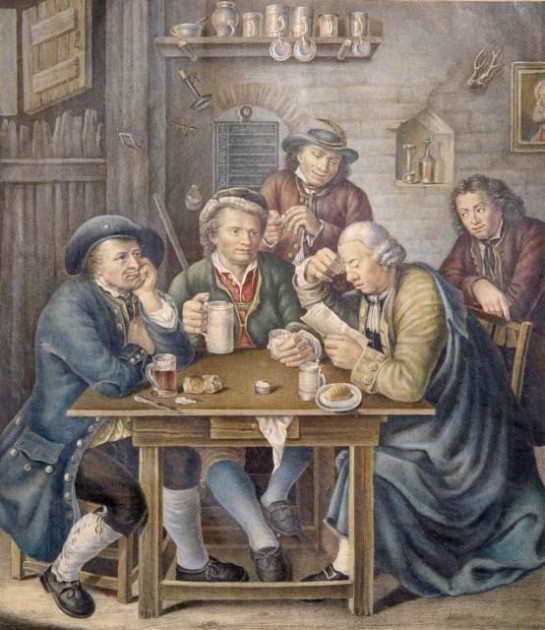
Due to the idiots that design and maintain this “Word Press” program, this entire site now has to be UNDER SEVERE EDITING IN LATE 2015.
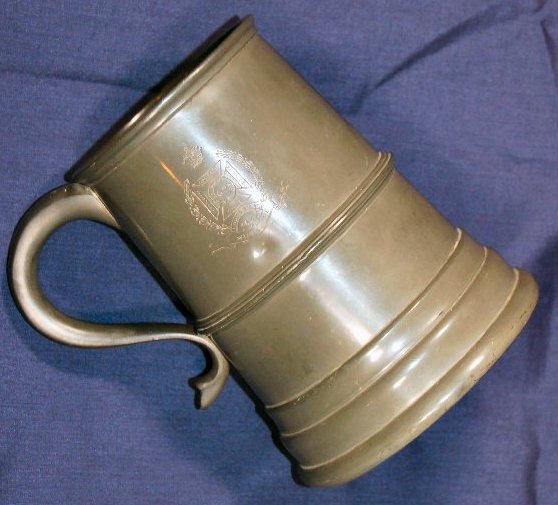 “C, Double” [or] Double-scroll handle — A sinuous line of S-shape, or composed of reverse curves, used frequently in the design of handles, mostly English pewter and sometimes silver. Shown above ▲: A British pewter mug for the 62ND Regiment (Inf.) Unknown exact age, BUT Circa 1870 I believe. It has 3 dice in the bottom between two glass bottoms. [FWTD] See a couple more photos under “Double C.”
“C, Double” [or] Double-scroll handle — A sinuous line of S-shape, or composed of reverse curves, used frequently in the design of handles, mostly English pewter and sometimes silver. Shown above ▲: A British pewter mug for the 62ND Regiment (Inf.) Unknown exact age, BUT Circa 1870 I believe. It has 3 dice in the bottom between two glass bottoms. [FWTD] See a couple more photos under “Double C.”
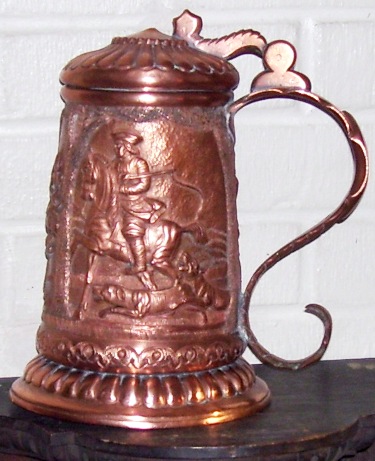 The bottom “C” is more pronounced. Austrian. One liter, very heavy copper (FEELS MORE LIKE BRONZE) Ca. 1850). [FWTD]
The bottom “C” is more pronounced. Austrian. One liter, very heavy copper (FEELS MORE LIKE BRONZE) Ca. 1850). [FWTD]
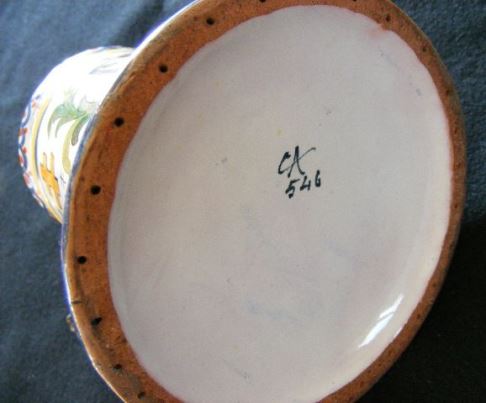
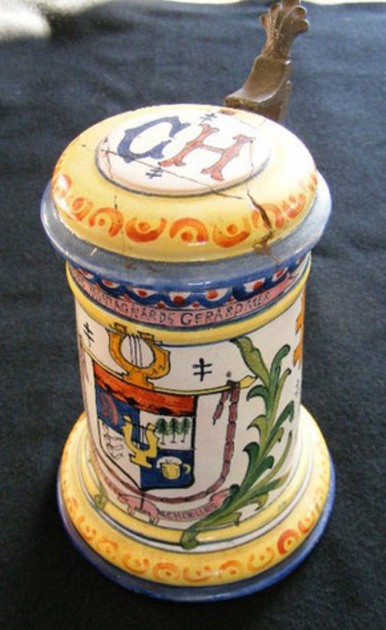 CA – Painted on Mark found on smaller French Fayence steins as shown below and above . Believed to be the firm of Alcide-Chaumeil. French C. 1900. Also see French fayence in this compendium.
CA – Painted on Mark found on smaller French Fayence steins as shown below and above . Believed to be the firm of Alcide-Chaumeil. French C. 1900. Also see French fayence in this compendium.
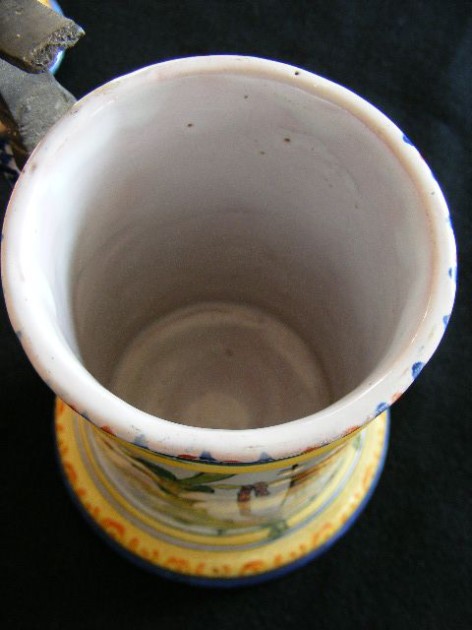
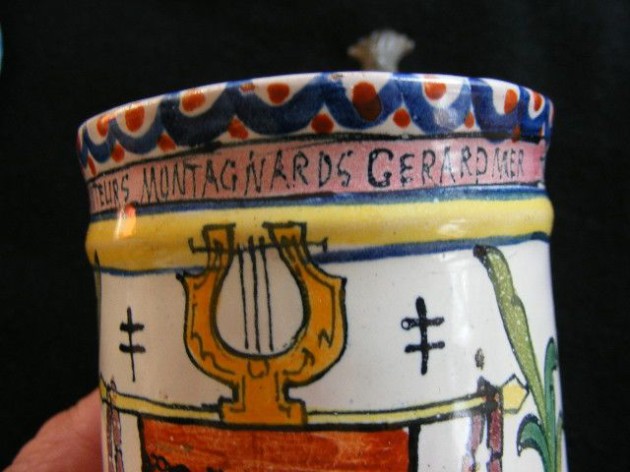 Detail – 1
Detail – 1
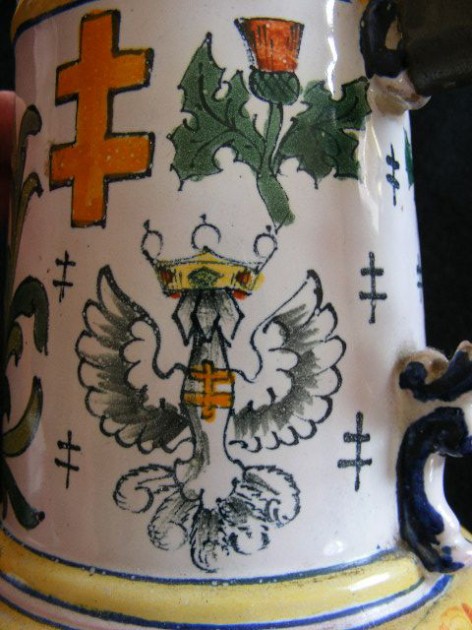 Detail – 2
Detail – 2
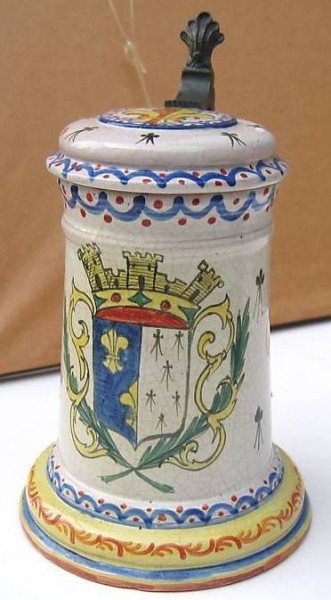 Another very similar beer stein
Another very similar beer stein
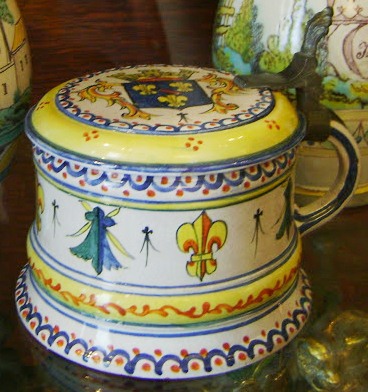 And Another !
And Another !
![RCXXX French Made Beer Stein DO I HAVE THIS ONE [qJ]](http://www.steveonsteins.com/wp-content/uploads/2011/01/RCXXX-French-Made-Beer-Stein-DO-I-HAVE-THIS-ONE-qJ-362x630.jpg)
ONCE MORE
Cabochon – The original meaning was a convex-cut, polished stone; now usually a raised piece of different colored glass on a stein body, goblet, wine or decanter. Several and most versions were made by “Myer’s Nef ” and most will be found called “Moser” on the “Antiques for sale “web sites. Examples of some of the colors below: I really like the purple {me and Barney!)
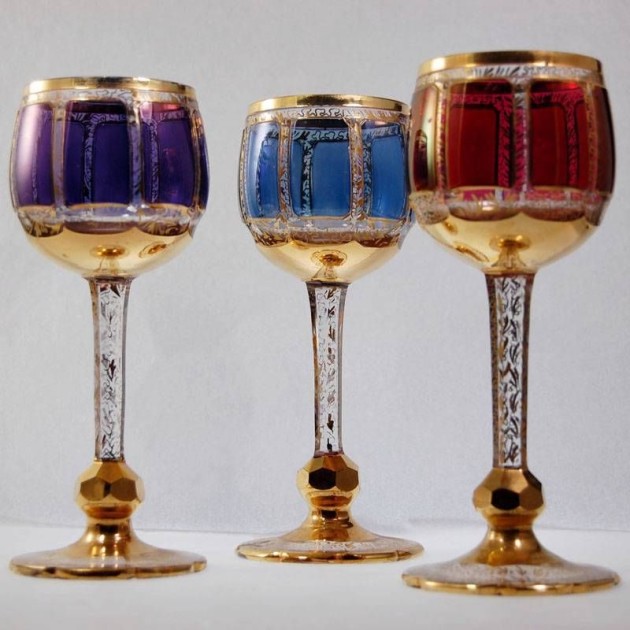
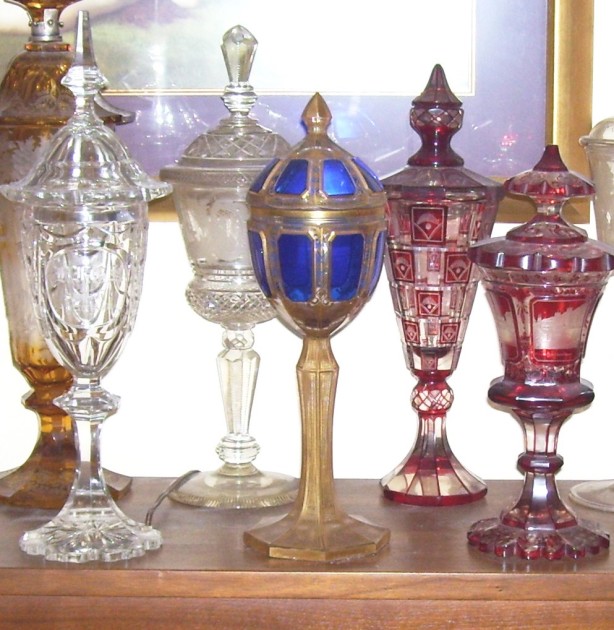
Pokal with cabochons. [center] , same maker as above. [FWTD]
Cage-work (or Caged Overlay) – When metal mounts encapsulate the body of the stein. Shown:Brass mounts. Circa 1910. This design has also been seen in a larger size with turquoises glass.
Also may be a “Wired stein” – Twisted wire around the molded indentations on the body pressed in, to hold the wire.
UNKNOWN SOLD PRICE VERY HARD TO FIND INTACT.
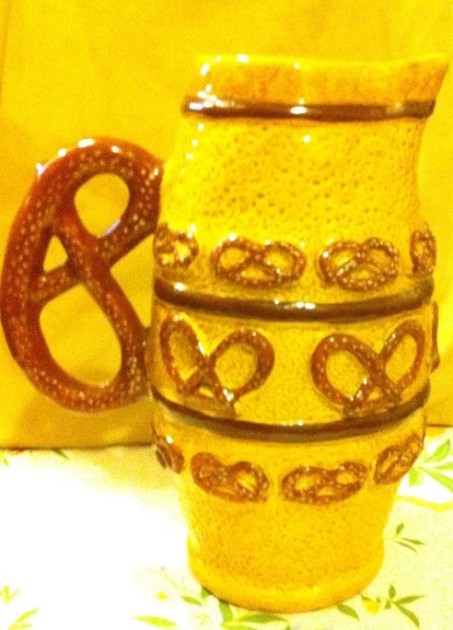
California pottery~ Not one of the biggest names in USA pottery circles. Above ▲ Vessel byBrayton Laguna~1940’s. Pretzel motif done on a Barrel Beer Server – Different but more appealing to a baker or pretzel freak I would guess.
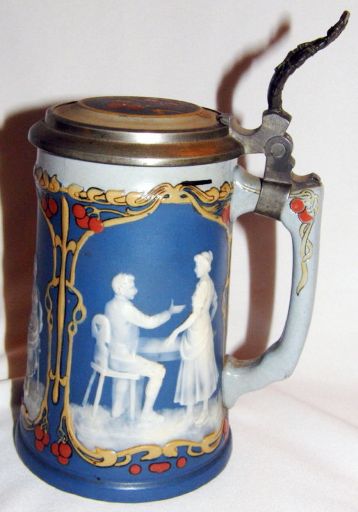
Cameo steins — A sub-set of V & B Mettlach steins designed with low relief made from a translucent porcelain-like material that allows contrasting background colors to show through the thinnest areas. Shown ▲: V &B Mettlach Cameo stein #2714.
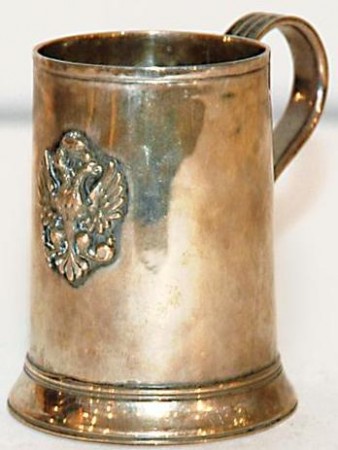 Cann – A “UK English” word used for what we call a “mug.” Usually made of silver or pewter. Shown: A sterling silver mug, made by Batemann in England ( a very good name in silver), with the Imperial Russian Arms attached to the front. would be rated a “7” ON the SMITH-PARATORE rarely scale. Very expensive!
Cann – A “UK English” word used for what we call a “mug.” Usually made of silver or pewter. Shown: A sterling silver mug, made by Batemann in England ( a very good name in silver), with the Imperial Russian Arms attached to the front. would be rated a “7” ON the SMITH-PARATORE rarely scale. Very expensive!
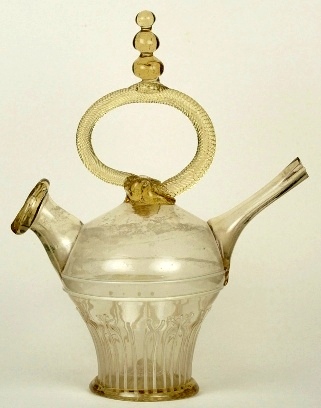 Cantir – A Spanish wine serving jug, usually made of glass and popular in that country in the the 1600 and 1700’s. Sometimes used to just pour wine down one’s own throat,= BEING HELD ABOVE THE HEAD AND AIMING IT JUST RIGHT!
Cantir – A Spanish wine serving jug, usually made of glass and popular in that country in the the 1600 and 1700’s. Sometimes used to just pour wine down one’s own throat,= BEING HELD ABOVE THE HEAD AND AIMING IT JUST RIGHT!
Capacity marks – Small impressed or incised, sometimes painted lines (as on porcelain) or marks to indicate the size of the drink up to that point on the stein. [Capacity mark info taken from an unknown article by Roy DeSelms, a SCI master steinologist : The metric system was not adopted in Germany until 1875. Therefore capacity marks in liters including “1 liter” would NOT have been seen on any German steins before 1875. The 1875 metric system adoption took some years to reach all of Germany so one can find even Mettlach steins made in 1885 without capacity marks For information on whose marks are on your pottery stein please see: http://www.thepatriotexchange.com/pss/capmarks.htm Also see: “S’ and “Summa” in this Compendium.
 Capacity pegs – A term that has been used by USA steins auctioneers. IS this amisnomer? NO! =It is absolutely wrong,!“See Peg Tankards” in Compendium = (Pa-Pi) .
Capacity pegs – A term that has been used by USA steins auctioneers. IS this amisnomer? NO! =It is absolutely wrong,!“See Peg Tankards” in Compendium = (Pa-Pi) .
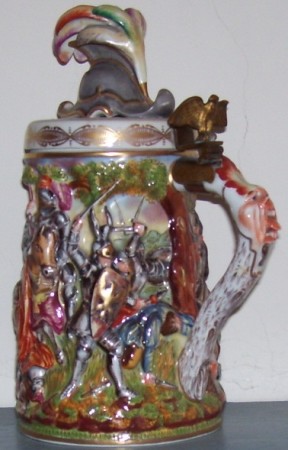
Capo-di-Monte – Another beer stein misnomer. The steins called this are made out of porcelain with very high relief and brightly colored. BUT –No beer steins were EVER made at the Capo-di-Monte factory! The ones collectors buy now , were for the most part made around Dresden, Germany in the mid to late 1800’s. They may or may not have the “Beehive mark” – which further complicates their origin, as that is the symbol for the Vienna porcelain steins of good quality and hand painted scenes, with gold leaf trim. “Doccia” porcelains steins [see “Caryatid” just below ▼ ▼] are also called “Capo ” by the USA stein auctioneers! It is a pity to havde really good quality items mixed in with what is usually as POS! Shown above ▲: Large one liter, molded relief, from Dresden. Check out the grotesque face on the handle, and Gilded brass adler thumblift. [JS]
photo gone Cappeller, L.M.K. – A not too well known Jugenstil designer. Shown: .5 liter stoneware. Dated 1904. These are reindeer! [tsaco]
CR- CARVED PEWTER, Antique Vintage 7 IN Pewter Lidded 3D Carved Pair Beer Steins MugsTankards EBAY 2-9-15 PUT ON DUMB SHITS PAGE
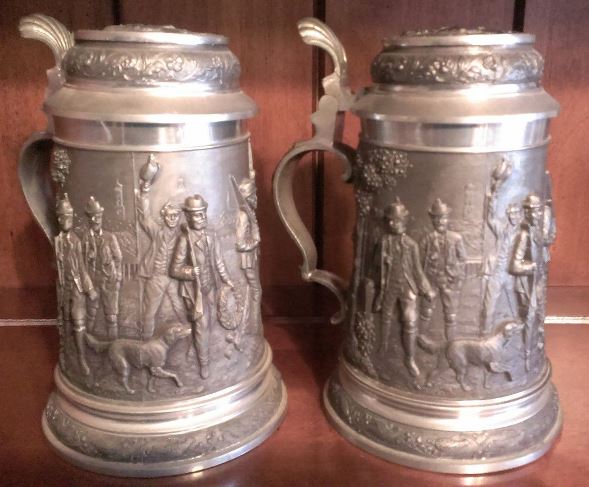
Caryatid — Female figure used as a support, as in architecture, or as a handle. Shown ▲: This Doccia porcelain stein (in the author’s collection) is 8 inches tall and oval in shape like the original ivory piece it was copied from. Being oval it is 4.2 inches wide and 5.2 inches to its longest diameter, the end with the handle.[ FWTD] See photo shown in “Character stein” just below for another “typical” example of a Caryatid.
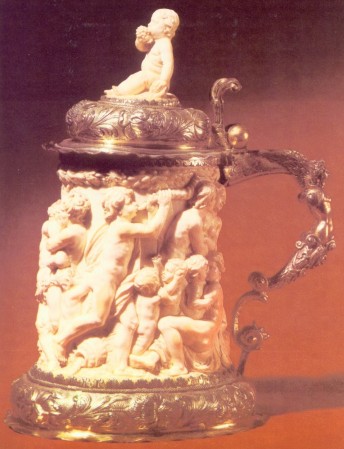
Cased glass – One layer of glass applied over another, then most often engraved away to produce an intaglio effect as ▲, or just a contrast as shown below▼ 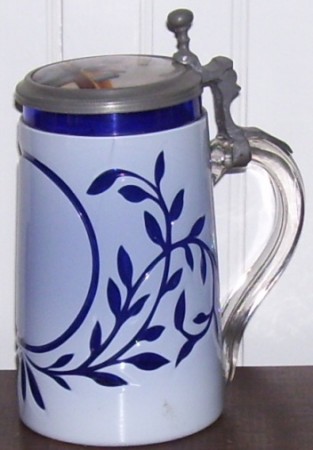 .5 liter cased white glass over blue glass (not stained blue), Bohemian I believe, Ca. 1850. [JS]
.5 liter cased white glass over blue glass (not stained blue), Bohemian I believe, Ca. 1850. [JS]
Cast Chasing — An ancient method of producing small parts, such as feet, handles or finials. An exact model of the required part is made in a soft material, from which an impression is taken in two halves, forming a mold when clamped together, into which molten silver can be poured.
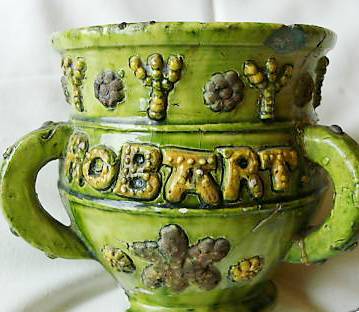 Castle Hedingham Ware – An art pottery studio founded by Edward Bingham at Castle Hedingham in Essex, England. It was in production from 1864 to 1901 and made miscellaneous items and drinking vessels in a style reminiscent of medieval and Tudor wares. Bingham produced some large items, with ‘Essex’ jugs up to three feet high being typical. Bingham also made many smaller yet colorful frequently mimicking the medieval revival style. Shown above: A medieval style “Tyge” by Bingham. Below: One of their marks = a real castle, not a “chapel” as on the V & B Mettlachs! For more info on this maker, see: http://www.steveonsteins.com/several-well-known-english-castle-hedingham-e-bingham-pottery-late-medieval-style-drinking-vessels-awpd-new-3-9-2013
Castle Hedingham Ware – An art pottery studio founded by Edward Bingham at Castle Hedingham in Essex, England. It was in production from 1864 to 1901 and made miscellaneous items and drinking vessels in a style reminiscent of medieval and Tudor wares. Bingham produced some large items, with ‘Essex’ jugs up to three feet high being typical. Bingham also made many smaller yet colorful frequently mimicking the medieval revival style. Shown above: A medieval style “Tyge” by Bingham. Below: One of their marks = a real castle, not a “chapel” as on the V & B Mettlachs! For more info on this maker, see: http://www.steveonsteins.com/several-well-known-english-castle-hedingham-e-bingham-pottery-late-medieval-style-drinking-vessels-awpd-new-3-9-2013
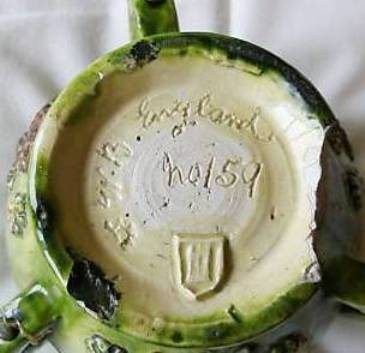 A true (part of an original ) castle mark was used by “Castle Hedington” wares. See also see: http://www.steveonsteins.com/several-well-known-english-castle-hedingham-e-bingham-pottery-late-medieval-style-drinking-vessels-awpd-new-3-9-2013
A true (part of an original ) castle mark was used by “Castle Hedington” wares. See also see: http://www.steveonsteins.com/several-well-known-english-castle-hedingham-e-bingham-pottery-late-medieval-style-drinking-vessels-awpd-new-3-9-2013
photo missing Castle mark – A stamped into the clay mark used by V & B Mettlach on beer steins and other wares . They also used the Green ink stamp mark ▲ as they did the green ink on the Mercury’s head mark. This term Castle is a ‘misnomer‘ as this is a representation of a “medieval chapel” left over on what was later to be V & B’s property, at Mettlach, is the closest town. See: http://www.steveonsteins.com/beer-stein-dictionary-1
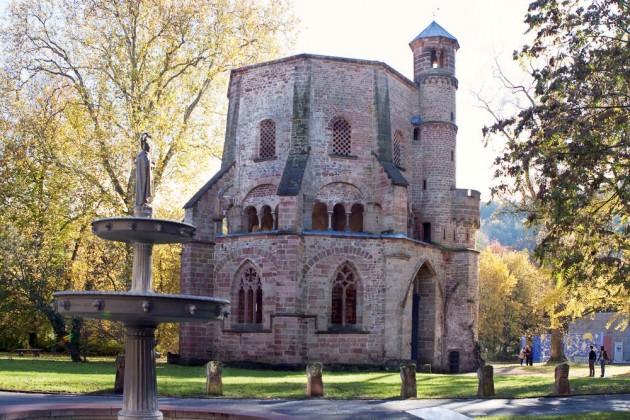
Casting — A method of shaping an object by melting the metal and pouring it into a specially prepared mold. On cooling, the metal retains the shape of the mold.
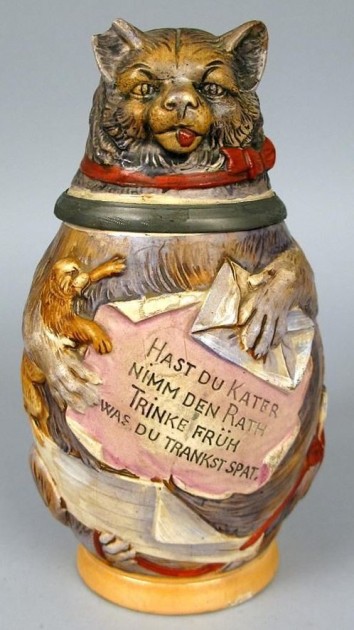 Cat steins – or cats on steins – well some people like them ! There are many times fewer cats on steins than on dogs – therefore I am not inclined to devote a page to them.
Cat steins – or cats on steins – well some people like them ! There are many times fewer cats on steins than on dogs – therefore I am not inclined to devote a page to them.
“Caveat emptor!” = “Let the buyer beware! – And as we beer steiners jokingly say here in Virginia: “The emperor eats caviar!”
Celluloid steins – are a class of compounds created from nitrocellulose and camphor, with added dyes and other agents. Generally considered the first thermoplastic, it was first created as Parkesine in 1862 and as Xylonite in 1869, before being registered as Celluloid in 1870.Another reference says: “John Wesley Hyatt only invented celluloid as a substitute for the ivory in billiard balls in 1868. He first tried using collodion a natural substance, after spilling a bottle of it and discovering that the material dried into a tough and flexible film. However the material was not strong enough to be used as a billiard ball, until the addition of camphor, a derivative of the laurel tree. The new celluloid could be molded with heat and pressure into a durable shape.” Celluloid is easily molded and shaped, and it was first widely used as an ivory replacement. Celluloid is highly flammable and also easily decomposes, and is no longer widely used. Its most common uses today are in table tennis balls and guitar picks. Celluloid steins are truly rare: See an example under “French Ivory” in this Compendium.
Ceramic beer steins – RECOMMENDED READING, PLEASE SEE: http://www.thepatriotexchange.com/pss/pottery.htm
Certified appraisal – See Appraisal
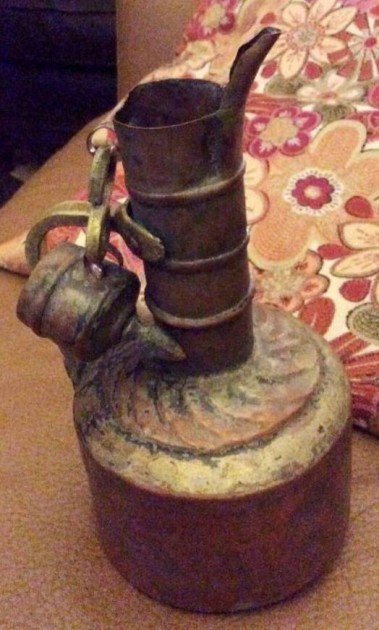 Chained lid to body drinking vessel –– Anytime one sees a lid that is chained to server or steins body; 95% of the time that piece will be from Persia (Now Iran, Turkey or some other old Ottoman Empire country. There was one seen in 2014 that probably originated in or around Bulgaria or Romania. It had a chain and lots of Bohemeian influence otherwise. These are not very collectable in the USA, as far as we stein collectors are concerned.
Chained lid to body drinking vessel –– Anytime one sees a lid that is chained to server or steins body; 95% of the time that piece will be from Persia (Now Iran, Turkey or some other old Ottoman Empire country. There was one seen in 2014 that probably originated in or around Bulgaria or Romania. It had a chain and lots of Bohemeian influence otherwise. These are not very collectable in the USA, as far as we stein collectors are concerned.
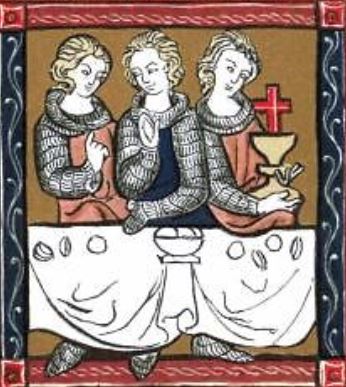 Chalice – Originally a vessel used to serve “Communion” in the church. Now-a-days, almost anything that resembles the antique shape of one. The word chalice should not mean the German ” Pokal “, (the English “Cup and Cover” ) or covered beakers. It is all very confusing but to clarify if it was used in a church then it is a chalice, if not it PROBABLY is not one! The exceptions to this so called rule would be for those homes that had separate worship spaces build into the home so that a visiting priest could come and have mass for the family. Oh man, the good old days when doctor’s and priests would come to your home !
Chalice – Originally a vessel used to serve “Communion” in the church. Now-a-days, almost anything that resembles the antique shape of one. The word chalice should not mean the German ” Pokal “, (the English “Cup and Cover” ) or covered beakers. It is all very confusing but to clarify if it was used in a church then it is a chalice, if not it PROBABLY is not one! The exceptions to this so called rule would be for those homes that had separate worship spaces build into the home so that a visiting priest could come and have mass for the family. Oh man, the good old days when doctor’s and priests would come to your home !
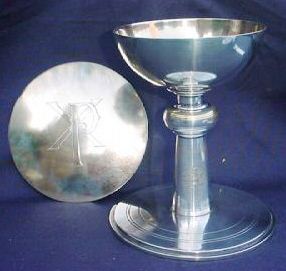 Shown: A silver Chalice with its paten, Belgium. Circa 1930.
Shown: A silver Chalice with its paten, Belgium. Circa 1930.
Here is a trio of nice looking chalices = “3 For Sale” here at S M & T ▼ ▼ ▼ (You might wish to check for availability before getting your hopes up 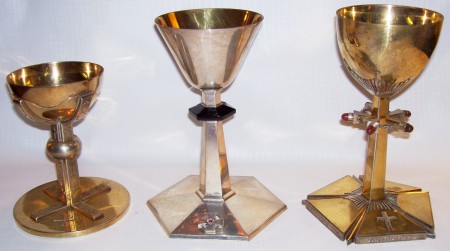 Three “Sterling silver” chalices – NOW ONE GREAT PRICE if you buy them all! Email me for prices please:
Three “Sterling silver” chalices – NOW ONE GREAT PRICE if you buy them all! Email me for prices please:
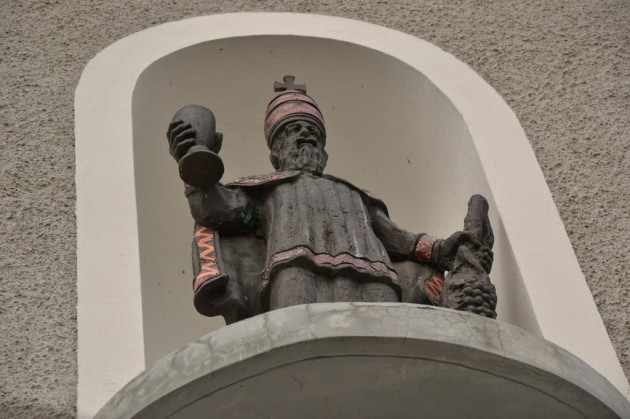
Shown above , the statue to Pope Urban date of birth unknown; died 23 May, 230. He is holding a chalice that is devoid of any religious symbolism and looks to me like a large German “Roemer”. http://www.steveonsteins.com/roemers-1-a-brief-account-of-their-history-and-a-small-pictorial-review I am not at all familiar with when this monument to him was created , but if anywhere near contemporary with Urban’s life it gives us an idea of how simple chalices were back then; at a minimum then it would be when the statue was formed; certainly no time close to us.
Perhaps the best way to say WHAT IS NOT A CHALICE is by using photos here are a couple:
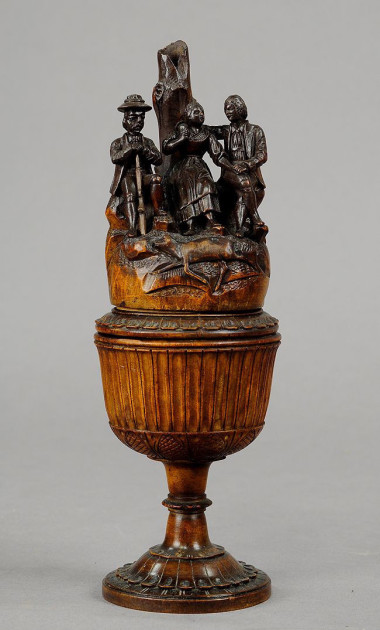
Circa 1850- 10.6 inches tall [FWTD]
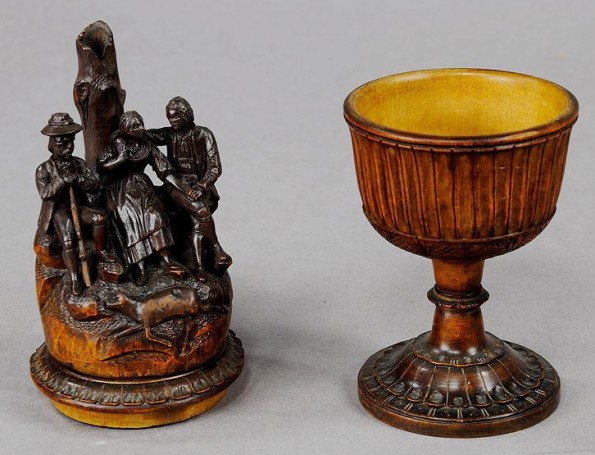
The Germans equivalent to an English Wassail cup. Made in Switzerland most likely, it was called “Black Fores”t as most older Swiss wooden items are,. [FWTD]
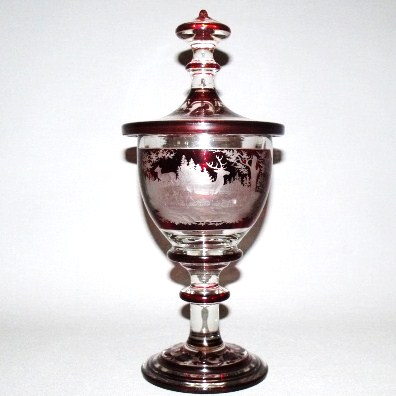
This one ▲ is called a POKAL . Bohemian, hunter’s motif with its cover, from 1830, 12 iNCHES For an interesting story about 4 Scottish chalices ending up in Virginia years later please see: http://www.steveonsteins.com/the-free-church-of-scotland-chalices-draft
Chalices used as ointment jars or vice versa- In lots of medieval religious paintings , what we would call chalices now-a-days were used as ointment jars. This entry came as a result of a challengein December of 2014 to an attribution of a saint shown in a museums book I thought it was St. Barbara whose attribute is a chalice and the museum called her Mary Magdalene ; whose one of many attribute is an ointment jar. (Even at my advanced age I continue to learn everyday, What a fascinating hobby this has been for the last 43 years . As copying of their photos has been is locked out at most of these Art History sites; for photos of such, the reader is asked to go direct to these pages: http://www.artnet.com/artists/master-of-the-mansi-magdalene/the-magdalen-holding-an-ointment-jar-an-extensive-YbZZau88kT_YniQZRRkPHw2 AND http://www.artnet.com/artists/master-of-the-mansi-magdalene/sainte-marie-madeleine-aH6xtK3vSrSJq2O9tIqQ_w2 AND http://www.artnet.com/artists/master-of-the-mansi-magdalene/sainte-marie-madeleine-ighPkKSHQb5fb7nxiARe7A2
![CHALKWARE EWER OR WINE SERVER Large Decorative Pitcher 17 INCHES TALL ITALIAN [Q]](http://www.steveonsteins.com/wp-content/uploads/2011/01/CHALKWARE-EWER-OR-WINE-SERVER-Large-Decorative-Pitcher-17-INCHES-TALL-ITALIAN-Q-339x630.jpg)
Chalkware – A substance made of molded gypsum and usually painted with strong based watercolors. These most typically those made in one of two periods. The first beginning in the late 1700’s and ending by the beginning of the 1900’s. The second period was during the “Great Depression“ which originated in the U.S., after the fall in stock prices that began around September 4, 1929, and became worldwide after the crash of the US stock market stock market on of October 29, 1929. Those made during the first period were more typically an attempt at serious art. Early chalkware vessels (beer steins, pitchers, etc. ) are difficult to find unblemished. Items such as these are still a staple “WIN’ at fairs throughout the USA, now being made in Mexico or China for the most part. I am certain there are collectors of this medium “out there” somewhere but most serious beer stein collectors wouldn’t be caught dead with any of these.
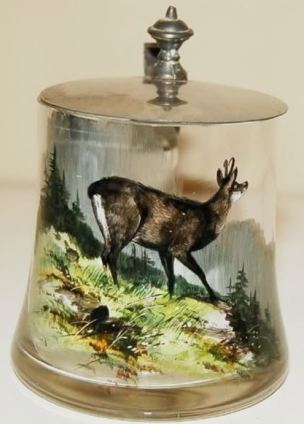
Chamois – A small member of the deer family found in the alps. Their leather skin is used for cleaning and now car washing; by the same name . The tell tail signs are the small curved horns. Chamois are found on a multitude of beer steins and they appeal greatly of course to hunters.
Character stein – A stein made to look like someone or something. I have seen characters made out of pottery, porcelain, stoneware, wood, pewter, silver, and ivory. One of the biggest “types” of steins collected worldwide, along with V &B Mettlachs, and Reservist’s steins. There have been several books published about them. Shown: About a one liter pewter character of Bacchus. [FWTD] Circa 1870. For much more information on “Character steins”, go to: http://www.charactersteins.com/csbook/default.htm Also see: http://www.beerstein.net/articles/char-stns.htm
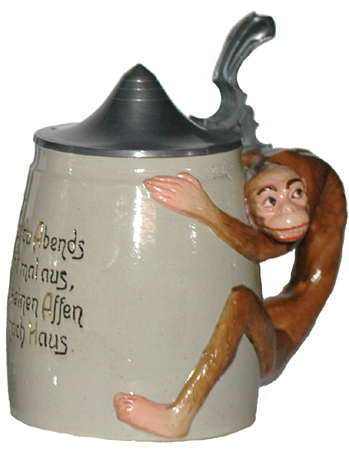
Recently seen at a major USA beer stein auction and listed as a “Character stein.” This no more meets the “definition” of a character stein than my ear lobe does!
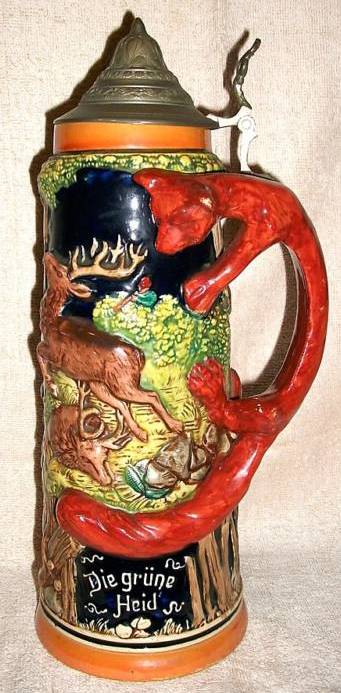
And if that above is a new definition of “character steins” then I guess this one fits that category now also = more auctioneer B.S !! As one can see by reading the following text sent to me by an established Character Stein collector, there seems to be no consistent definition anywhere. I enjoyed the comment highlighted in blue, kind of sums it all up. “How about: “A stein made to look like a person, animal, bird, reptile or object”. Some character steins refer to sports, for example, such as weight-lifting, cards, chess, bowling, tennis, etc., even tho they do not represent the actual object. A card stein can show playing cards, and be considered a character stein, even tho the stein does not resemble an individual card. I suppose it’s an individual call, but some of the steins shown in the first two character stein books, did NOT show character steins – in my opinion. The pillow fight is one example – the two steins you show below are others. Having a character for a handle does NOT make it a character stein. I suppose one could refer to them as “character related” or “partial character” steins. There are a lot of “tower” steins that are actually only towers if you look at the lids – the bodies are somewhat a melange – being part tower and part something else w/ sayings and out of scale people mixed into the design. In the purest sense, the “herring stein” is not a character stein, since it not only depicts a bunch of fish, but it also has a cat and a monkey peeking out at each other from the clump of fish – something you’d never see in the real world. It’s kinda like the Supreme Court’s definition of pornography: You know it when you see it.”
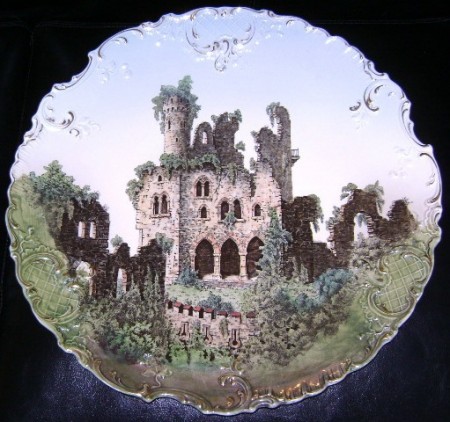
Charger – Technically any wall plate over the size of 16 inches. And “a charger is a large platter that holds meat, In Medieval England , the tray of meat was carried to the table by a servant. That person was also called a “charger!” Shown ▲: A very popular V & B Mettlach PUG mistakenly called a “small charger” (really just a “plate” as it less than 16 inches, but larger than 9 inches) of an old castle in ruins. Dec 167.
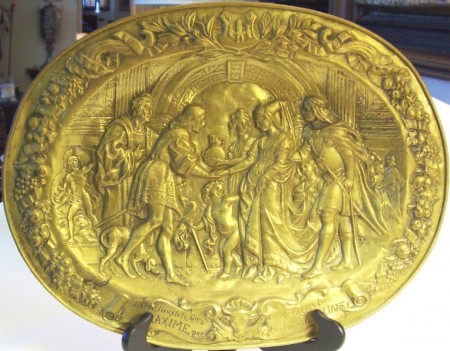
A lot of these “chargers” show drinking scenes and make for as nice display in a bar area. Shown: The Emperor Maximilian meeting Mary of Burgundy, his future wife. Notice the female attendant standing ready with the wine pitcher. 18 inch wide by 14 inch tall, oval copper wall plaque with stamped relief and a hand twisted edge. The coat of arms on the top rim of towers and hands is from the city of Antwerp, now in Belgium. There is also a small icon of St. Luke as an ox on the bottom rim. Circa: Early 1800’s.; most likely Dutch made. [FWTD]
CR-CHARLES MEIGH [ENG] Apostles Jug English Gothic Religious Charles Meigh Stoneware
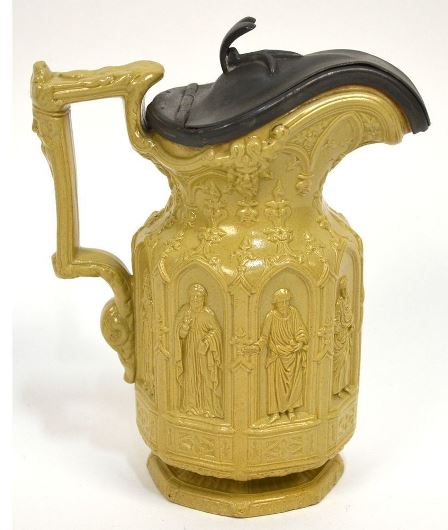
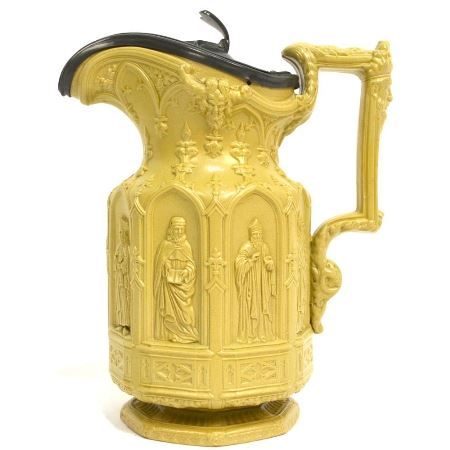
CR- Charlotte Kraus –Design [PJ] Jugendstil Beer Stein
![CR- Charlotte Kraus --Design [PJ] Jugendstil Beer Stein](http://www.steveonsteins.com/wp-content/uploads/2011/01/CR-Charlotte-Kraus-Design-PJ-Jugendstil-Beer-Stein.jpg)
 Charm steins – Tiny steins made out of various material but mostly silver. Lots of SCI wives wear these as necklaces to conventions and local meetings. The manufacturers have made 100’s of various models over several decades; most are in small relief. Some “miniature steins” such as the one shown above are called “charms” even though there is no way of attaching it to a charm bracelet.
Charm steins – Tiny steins made out of various material but mostly silver. Lots of SCI wives wear these as necklaces to conventions and local meetings. The manufacturers have made 100’s of various models over several decades; most are in small relief. Some “miniature steins” such as the one shown above are called “charms” even though there is no way of attaching it to a charm bracelet.
Chasing — The decoration of silver by the use of punches, removing no silver in the process.
CR- Chesapeake Pottery Large SERVER Colorful Faience Earthenware Haynes Balt Ware Art Deco Pattern ca.1900 -1914 DESIGN BY DF Haynes
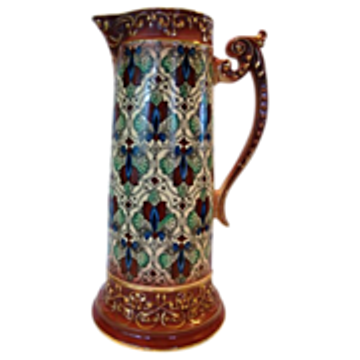
Checker board pattern – Shown: Pretty self explanatory. [L]: Engraved glass. Circa 1790. [R]: A “Birnkannen” (Pear shaped jug) Circa 1850. These checkerboards were very popular on Birnkannen about 1790-1820.
![1W CHERUBS SHORT FOR ANGELS = CERIBUMS [SP]](http://www.steveonsteins.com/wp-content/uploads/2010/08/1W-CHERUBS-SHORT-FOR-ANGELS-CERIBUMS-SP.jpg) Cherubs – Short for “Cherubim,” a type of angel. “Putti” are similar but have no wings. Most people do not know that even the angels in Heaven have a hierarchy! The ones closesat to God are of the “First Hierarchy” and go downward. Bet you-all didn’t know that?! Shown: ▲ A detail from a .5 liter pewter relief stein. Circa 1890. • First Hierarchy o Seraphim o Cherubim o Thrones [or Ophanim] • Second Hierarchy o Dominions o Virtues o Powers • Third Hierarchy o Principalities o Archangels o Angels
Cherubs – Short for “Cherubim,” a type of angel. “Putti” are similar but have no wings. Most people do not know that even the angels in Heaven have a hierarchy! The ones closesat to God are of the “First Hierarchy” and go downward. Bet you-all didn’t know that?! Shown: ▲ A detail from a .5 liter pewter relief stein. Circa 1890. • First Hierarchy o Seraphim o Cherubim o Thrones [or Ophanim] • Second Hierarchy o Dominions o Virtues o Powers • Third Hierarchy o Principalities o Archangels o Angels ![1 - cheribum in already [q]](http://www.steveonsteins.com/wp-content/uploads/2011/01/1-cheribum-in-already-q.jpg) Shown: Another Cherub as the center panel. Gambrinus finial Circa 1880-90. These little “guys” were very popular on all types of art work beginning in the Renaissance and continuing afterwards. The stein shown more than likely was made by J. Lichtinger in Munich.
Shown: Another Cherub as the center panel. Gambrinus finial Circa 1880-90. These little “guys” were very popular on all types of art work beginning in the Renaissance and continuing afterwards. The stein shown more than likely was made by J. Lichtinger in Munich. 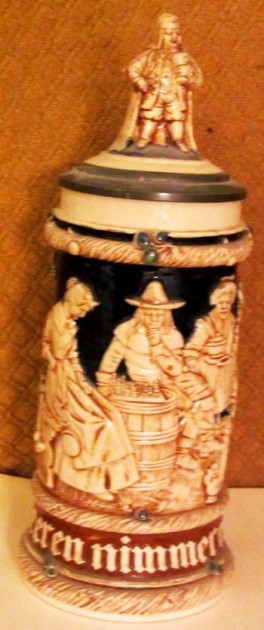 .
. 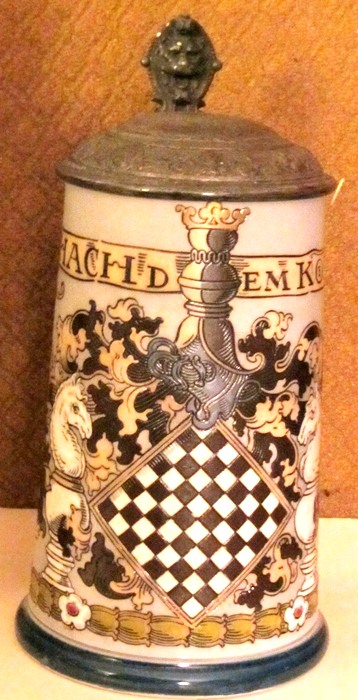 Chess, game of, steins = Self explanatory – Top: A .5 liter pottery relief of players. Bottom: A V & B Mettlach. Very collectable as it is a “cross-over” piece.
Chess, game of, steins = Self explanatory – Top: A .5 liter pottery relief of players. Bottom: A V & B Mettlach. Very collectable as it is a “cross-over” piece.
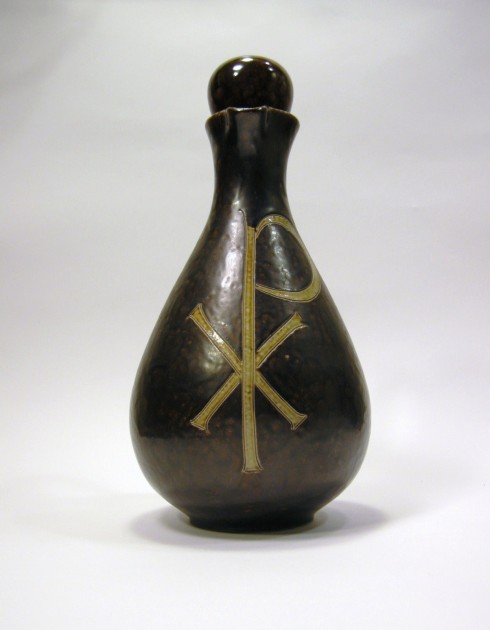
Chi Rho – Here is a beautiful stoneware jug or decanter with a corked ceramic stopper by the famous German ceramic potter Elfriede Balzar Kopp.Approximately 11 inches tall and 5 1/2 inches wide and 6 inches from the handle to the front. This beautiful hand made jug which I believe is meant for Sacramental wine has a lovely rich dark brown dappled glaze over a lighter tan glaze. It has the Chi Rho incised on the front which is one of the earliest forms of christogramand. It is colored with a light tan glaze. It is marked on the bottom with an incised mark that says, Balzar – Kopp Hohr. There is also a small black red and gold label in the shape of a painters pallet that says, Keramik Weber Koln. This beautiful piece of pottery measures approximately 11″ inches tall and 5 1/2″ inches wide and 6″ inches from the handle to the front. This piece is in perfect condition with no chips or cracks. Elfriede Balzar Kopp was a famous German ceramic potter . She was born Elfriede Kopp in Berdorf, Luxembourg in 1904 and her surname changed to Balzar-Kopp upon marriage circa 1927. Died Höhr-Grenzhausenfont in 1983. Active 1927 – 1973. Formed the G.m.b.H in 1930.Collaborated in techniques with Wim Mühlendyck. The Chi Rho is one of the earliest cruciform symbols used by Christians. It is formed by superimposing the first two letters of the word “Christ” in Greek, chi = ch and rho = r. Although not technically a cross, the Chi Rho invokes the crucifixion of Jesus as well as symbolizing his status as the Christ. The earliest evidence of the Chi Rho symbol is Constantine’s use of it on the labarum, the imperial standard, in the early 4th century CE. Lactantius, a 4th century Christian apologist, reports that on the eve of the Battle of the Milvian Bridge in 312 CE, Constantine had a vision of God in which he was commanded to mark his men’s shields with the Chi Rho symbol. After Constantine’s success at the Milvian bridge, the Chi Rho became the official imperial insignia. Archaeologists have uncovered evidence demonstrating that the Chi Rho was emblazoned on the helmet and shield of Constantine as well as those of all of his soldiers. Coins and medallions minted during Constantine’s reign also bore the Chi Rho. By the year 350 CE, the Chi Rho began to be used on Christian sarcophagi and frescoes.
Chinese drinking horns – A series of newer, rather large drinking horns, done with heavy brass bodies, some are silver plated, and come with decorated porcelain or cut glass horns of different colors. They certainly are substantial. I have one done in cut ruby glass; “BUT” some sellers are charging the old “arm and a leg” for them, having no idea that they are almost brand new. Be careful out there kids! (A very dirty porcelain one sold at a stein auction in Nov 2011 for about $900! Wow!)
CR- Chinese porcelain famille rose ewer dating from the 18th century. height 25cm diameter of body 14cm
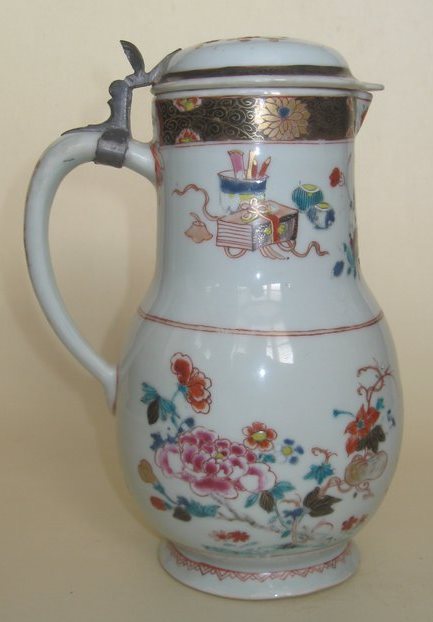
![CHINASOIE [SP]](http://www.steveonsteins.com/wp-content/uploads/2011/01/CHINASOIE-SP-261x450.jpg)
Chinoiserie— Decoration in the Chinese style, popular throughout Europe, particularly France: (1) Embossing with Chinese figures in the Dutch style; (2) Linear decoration in flat chasing, exclusive to England, c. 1680-1690 (referred to as Chinoiserie throughout, all else being “in the Chinese style”); (3) Repousse Rococo decoration using Chinese motifs, mainly found on objects concerned with tea, c. 1750. Shown: Chinoiserie design on a Hannover [?] Fayence stein from the 1700′ s. [FWTD]
Chip carved steins – A process for decorating wood by using chisel type instruments. The Scandinavians carried this art form to a high degree of perfection in the mid to late 1800’s, copying some of the ancient Celtic interwoven designs. Shown: Possibly Danish, chip carved 1.5 liter stein.
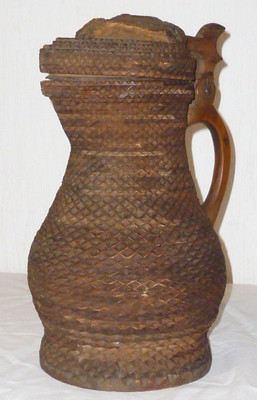
A “chipped carved” wood kind of extreme, Ht. 15 inches. This type is also called “Tramp Art.” This one could possibly be unique.
.
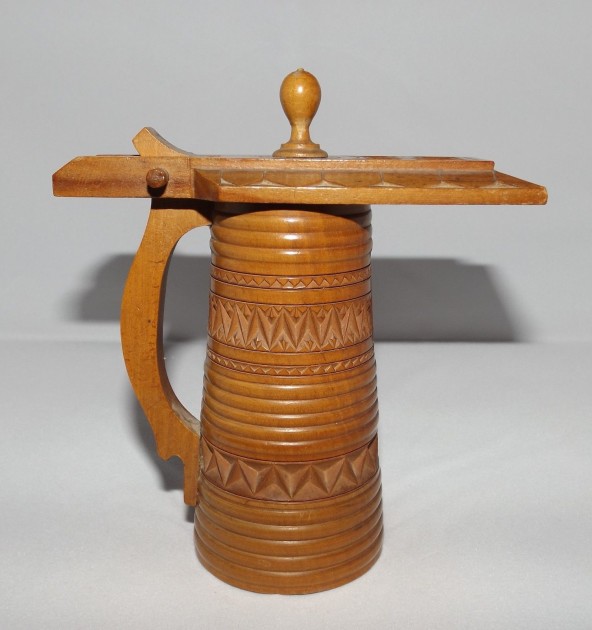
What appears at first glace to be a Bavarian pointed lid stein is not. This is very unusual chip carved Norwegian [I believe [or Dutch] “creation” . I just had to included it for my reader’s pleasure. It is so unusual, I do wish this one was in [FWTD] .The long board top looks like an old bed or lined smoother.
.
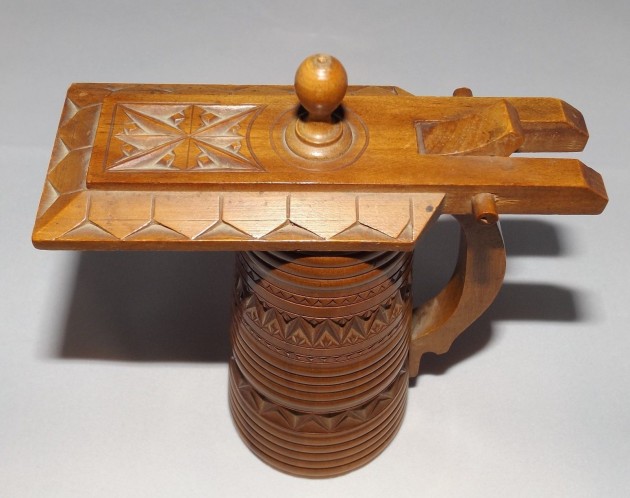
CR- CHITTENANGO POTTERY NY PUG BEER STEIN Chittenango Pottery steins – .5 liter PUG. Made in the USA.
c.1900 PEWTER LID MANNING & BOWMAN .3L HAVE IT ][Q]
![CR- CHITTENANGO POTTERY NY PUG BEER STEIN c.1900 PEWTER LID MANNING & BOWMAN .3L HAVE IT ][Q]](http://www.steveonsteins.com/wp-content/uploads/2011/01/CR-CHITTENANGO-POTTERY-NY-PUG-BEER-STEIN-c.1900-PEWTER-LID-MANNING-BOWMAN-.3L-HAVE-IT-Q-576x630.jpg)
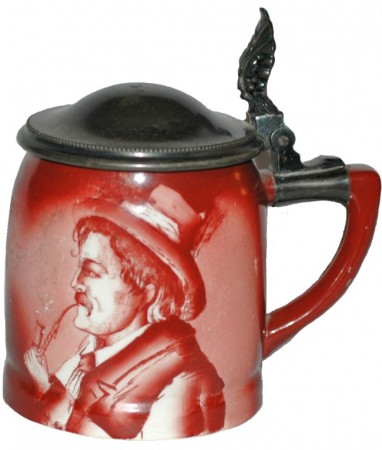
CR- CHRISTIAN INDICATIONS — LAMB OF GOD. ON ENGRAVED GLASS FOR A BUTCHER – WITH
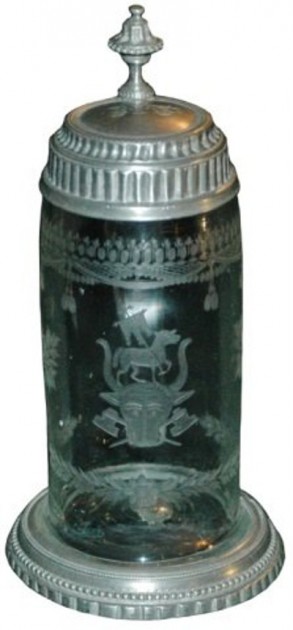
CR- CHOCOLATE BROWN GLAZE BODY GERZ [TSACO]
![CR- CHOCOLATE BROWN GLAZE BODY GERZ [TSACO]](http://www.steveonsteins.com/wp-content/uploads/2011/01/CR-CHOCOLATE-BROWN-GLAZE-BODY-GERZ-TSACO.jpg)
For infomation: http://www.steinmarks.co.uk/pages/pv.asp?p=stein1 [END – SOK – 56 – R5]

“I didn’t use to finish sentences, but now I just

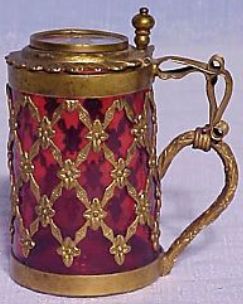
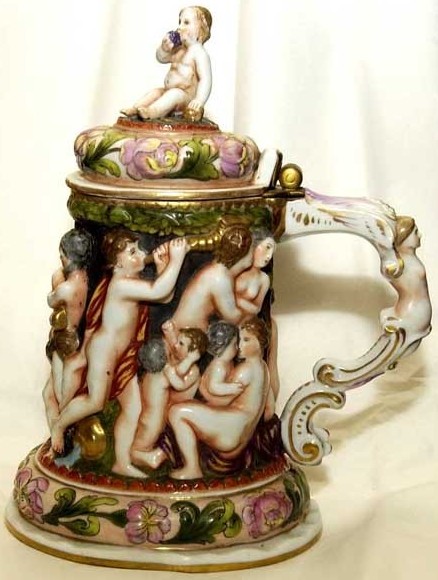
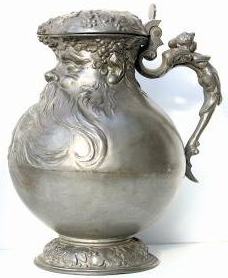
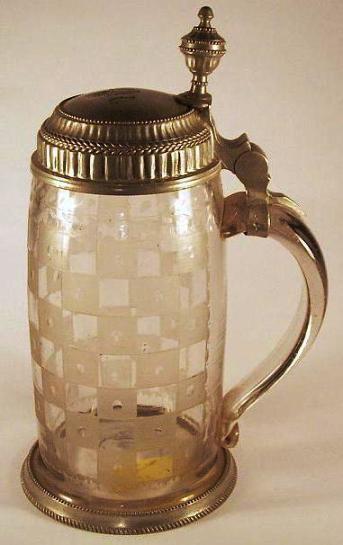
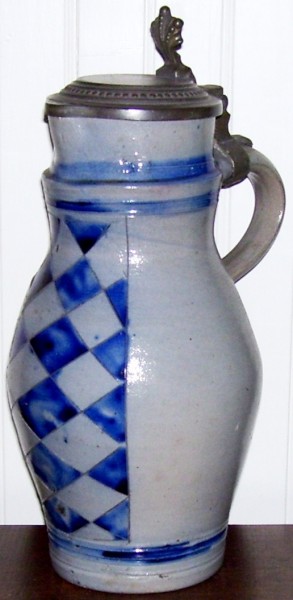
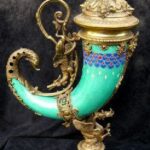
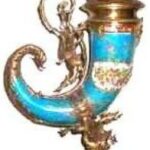
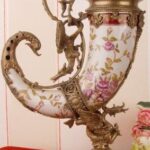
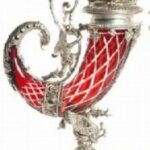
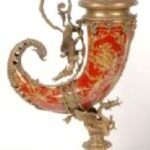
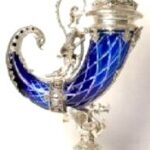
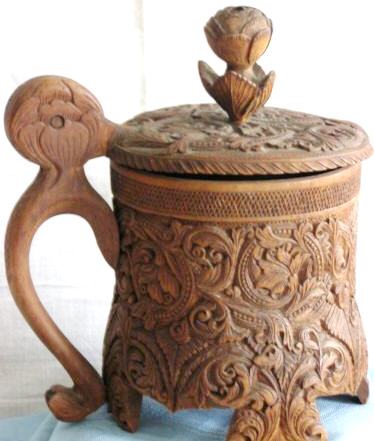
Leave a Reply